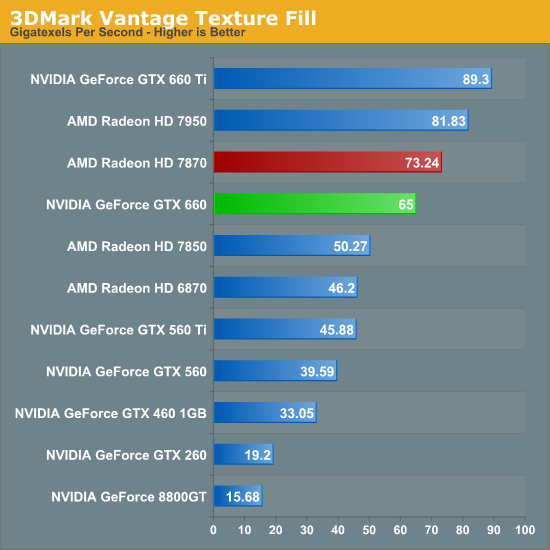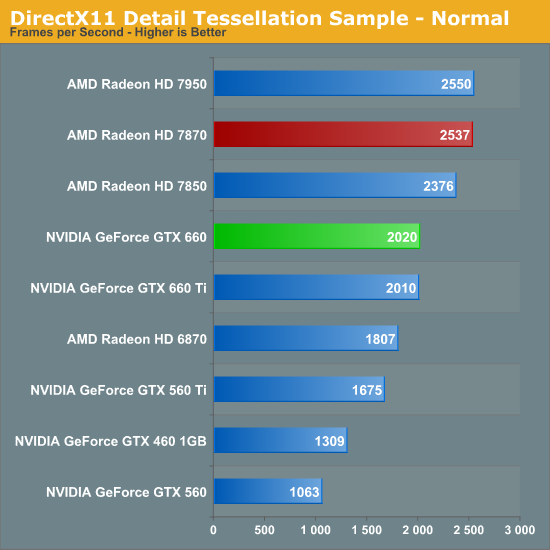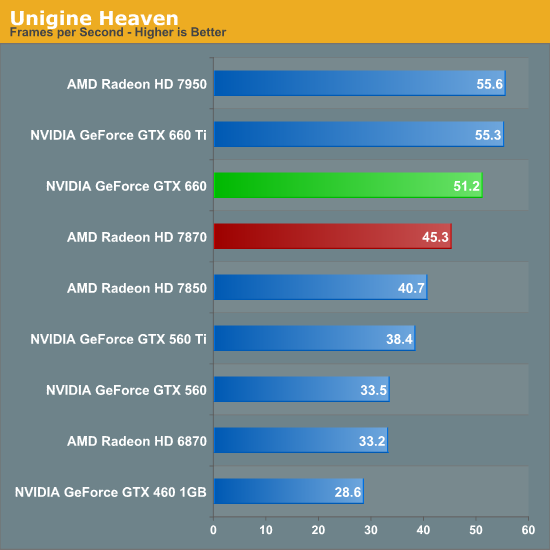The NVIDIA GeForce GTX 660 Review: GK106 Fills Out The Kepler Family
by Ryan Smith on September 13, 2012 9:00 AM ESTSynthetics
As always we’ll also take a quick look at synthetic performance to see if NVIDIA’s core configuration has had any impact on basis performance metrics. We’re expecting to see performance very close to the GTX 660 Ti, due to its nearly identical ROP/L2/memory configuration. We’ll start with 3DMark Vantage’s Pixel Fill test.

3DMark Vantage’s pixel fill test likes memory bandwidth and ROP performance in that order, which makes these results a bit odd. With identical memory bandwidth between them we’d expect the GTX 660 and GTX 660 Ti to at least be tied here, if not a slight lead for the GTX 660 thanks to its higher ROP performance. Instead the GTX 660 trails the GTX 660 Ti by a slight amount, an outcome we can’t explain at this time.

Our texture fillrate benchmark on the other hand sees a large gap between the GTX 660 and GTX 660 Ti, which is what we would expect from the loss of SMXes.
Our third theoretical test is the set of settings we use with Microsoft’s Detail Tessellation sample program out of the DX11 SDK


Despite the loss of SMXes (and thereby Polymorph engines), our tessellation benchmarks don’t show any kind of significant difference between the GTX 660 and GTX 660 Ti. We’ve been finding this benchmark to be surprisingly sensitive to ROP performance and memory bandwidth on Kepler, and these results back that finding.
Our final theoretical test is Unigine Heaven 2.5, a benchmark that straddles the line between a synthetic benchmark and a real-world benchmark as the engine is licensed but no notable DX11 games have been produced using it yet.

Despite its advanced nature, Heaven isn’t particularly sensitive to the loss of shader and texturing performance, as signified by the performance loss of less than 10% for the GTX 660.










147 Comments
View All Comments
yeeeeman - Saturday, September 15, 2012 - link
Really, G80 was a revolution on its own. Spectacular jump in performance compared to the previous generation, and combined with 65nm process technology gave birth to some of the finest video cards.The real setback here, is the fact that the gaming industry is driven by the lowest common denominator, and we all know that consoles are the most important. They are sold in the largest quantities, and most games are designed for their power, not higher.
For PCs, games receive a DX11 treatment, with some fancy features, than enhance the quality a little bit, but it can never make up for the fact that the textures and the game is designed for a much slower platform.
So given these facts, why change my 9600GT, when it can handle pretty much everything?
steelnewfie - Saturday, September 15, 2012 - link
"For the 2GB GTX 660, NVIDIA has outfit the card with 8 2Gb memory modules"Should read outfitted.
Also 8 2Gb memory modules? Did you mean 2GB? Either is incorrect by my math.
If there are 8 banks should not each module be 256 MB?
Otherwise, great articles, keep up the good work!
Ryan Smith - Saturday, September 15, 2012 - link
Individual memory modules are labeled by their capacity in bits, not bytes. So each module is 2 gigabits (Gb), which is 256MB. 8x2Gb is how the card ends up with 2 gigabytes (GB) of RAM.MrBubbles - Saturday, September 15, 2012 - link
Cool, I have a GTX 260 and since NVidia is deliberately breaking their driver support for games like Civ 5 I guess this is the card to get.saturn85 - Saturday, September 15, 2012 - link
nice folding@home benchmark.JWill97 - Thursday, September 27, 2012 - link
For me, I really think it's the best card you can buy at this price. Not a fan (neutral) of both NVidia or AMD, but really, at $200+ segment nvidia takes it. But I still wondering, why all reviewers aren't using Maxpayne3 as one of the game benchmark? A lot of cards would be struggle playing it.Grawbad - Friday, March 1, 2013 - link
"NVIDIA has spent a lot of time in the past couple of years worrying about the 8800GT/9800GT in particular. “The only card that matters” was a massive hit for the company straight up through 2010, which has made it difficult to get users to upgrade even 4 years later."I am one of those. I purchased a 9800 GTX and that sucker runs everything. Mind you, all my other components were quality too so I didn't bottleneck myself. But this card has run everything I have ever thrown at it.. Only recently have I had to start watching the AA a bit. Which is why I am now, 5 years later in the market for a new card. 5 Years.
Indeed, those cards were astounding.
Mine was an EVGA 9800 GTX with a lifetime warranty. Thank goodness for that as it finally went out on me this year and I had to RMA it. And now that I am looking into getting a new card it seems EVGA has dropped their lifetime warranty. That makes me sad.
Anyways, yeah, those were are are still great cards. I mean, if you picked up a 9800 GTX today, you will be able to run even the newest games. Albeit youll need to turn down aa and such, but you can still get GREAT graphics out of most anything even today.